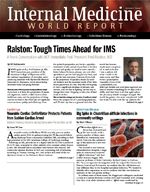Patients with Mild Emphysema Likely to See Changes in Bone Mineral Density
Patients with Mild Emphysema Likely to See Changes in Bone Mineral Density
IMs Should Look for Loss of BMD in More Patients
By Kurt Ullman
Studies have shown a link between chronic obstructive pulmonary disorder (COPD) and low bone mineral density (BMD) in smokers. Now, new research finds that radiographic evidence of mild emphysema is linked to changes in BMD even in patients with no airflow obstruction.
“We know that certain risk factors such as smoking, steroid use, lack of exercise have been linked to both obstructive lung disease and lowering of BMD,” said Jessica Bon, MD, from the Division of Pulmonary, Allergy and Critical Care Medicine at the University of Pittsburgh School of Medicine. “However, little is known about the specific relationship to emphysema.
One hundred and ninety-nine subjects completed a CT scan, pulmonary function testing, questionnaires, and a dual x-ray absorptiometry (DXA) of the hip and lumbar spine. They were participants in the Pittsburgh Lung Screening study cohort. They were classified as having normal BMD, osteopenia, or osteoporosis. Demographics, physiologic, and radiographic characteristics were compared. The association of BMD with radiographic emphysema, airflow obstruction, and osteoporosis risk factors were examined.
The researchers found no differences in age, tobacco exposure, oral steroid use, or physical activity across BMD categories. Both osteopenia and osteoporosis were associated with airflow obstruction, inhaled steroid use, and female sex. There was a significant relationship with presence of visual emphysema (P = 0.0003). Quantitative emphysema, but not CT-measured airway wall thickness, was inversely associated with bone mineral density. Visual emphysema alone was a significant predictor of osteopenia/osteoporosis (odd ratio= 2.55; 95% confidence interval, 1.24-5.25) in a model that included obstruction severity, age, sex, and both inhaled and oral steroid use.
“Most of our patients were highly functional, did not have lot of risk factors besides smoking exposure, and the majority had mild lung disease or none at all,” she said. “When we looked at the CT scans, we noted that even those with as little as 10% of their lungs affected by holes had a significantly increased risk for low BMD. This was in a group pulled from a lung cancer CT screening cohort. Many [patients] did not even know they had any lung disease when they decided to get screened.”
Dr. Bon says that the finding is important because physicians tend to be more vigilant in ordering DXA and other tests in those who are debilitated from their lung disease. However, they may not as often order density testing in those with less severe disease, especially males.
“There are a lot of smokers with lung diseases that may not be seen by the pulmonologist,” she said. “Many of these patients may be picked up in the community because their emphysema was discovered while looking for something else. Just because they are not in major trouble doesn’t mean that doctors should not be closely tracking bone mineral density.”
The research was supported by grants from the National Institutes of Health and the Snee-Reinhardt Foundation. One or more of the participants in the study received con osteoporosis sultancy and advisory board payments from pharmaceutical companies.
Source:Bon J, et al. Radiographic emphysema predicts low bone mineral density in a tobacco-exposed cohort. Am J Respir Crit Care Med. 2011;183;885-890.
